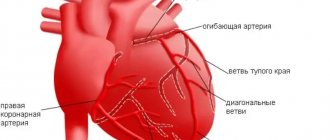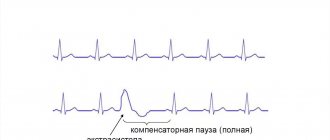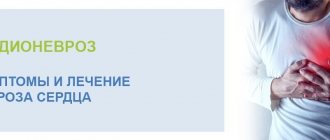Clinical manifestations
Myocardial infarction can be either the first manifestation of coronary heart disease or occur against the background of long-term angina. The main symptom of myocardial infarction is an attack of unusually intense chest pain, which in patients with angina pectoris does not go away after taking the usual doses of nitroglycerin.
The pain is usually wave-like and can often spread to the left arm, shoulder blade, neck, and teeth. Myocardial infarction occurs both against the background of high blood pressure, and may be accompanied by a decrease in blood pressure with a sharp deterioration in the general condition (severe weakness, cold sweat, nausea). One of the characteristic signs of a heart attack is the fear of death.
Manifestations of a heart attack may differ from the classic picture. There are so-called atypical forms.
Abdominal form
manifested by severe abdominal pain, nausea, vomiting, and digestive disorders.
Asthmatic form
may occur as an attack of bronchial asthma (shortness of breath, difficulty breathing, feeling of lack of air). One of the most insidious forms of myocardial infarction is painless, which occurs without a typical painful attack (angina). The only manifestation of this form may be an unexplained deterioration in general condition, decreased tolerance to physical activity, and weakness.
Express diagnosis of myocardial infarction
Cardiac markers:
05.09.2018
Shibanov A.N., Gervaziev Yu.V.
Myocardial infarction (MI) is one of the main causes of death in civilized countries. According to data presented at the Board of the Ministry of Health and Social Development in 2008, in the structure of causes of mortality in Russia, MI accounts for 20% and ranks second, only slightly inferior to cerebrovascular diseases.
Over the past 20 years, world medicine has made great strides in the treatment of cardiovascular diseases, including MI. Methods such as thrombolytic therapy, reperfusion of the heart muscle, and balloon angioplasty in many cases can restore blood circulation in the heart muscle and save the patient’s life. The effectiveness of these methods depends critically on the time between the onset of acute heart failure and the start of treatment. Every hour of delay significantly reduces the likelihood of a positive outcome. Therefore, timely diagnosis plays an important role in the successful treatment of MI.
Diagnosis of MI is based on 3 groups of criteria:
- history and physical examination;
- instrumental research data;
- determination of cardiac markers in the blood: proteins specific to the infarction state.
History and physical examination data are essentially subjective and cannot serve as criteria for diagnosing myocardial infarction. The purpose of the physical examination is, first of all, to exclude non-cardiac causes of chest pain (pleurisy, pneumothorax, myositis, inflammatory diseases of the musculoskeletal system, chest trauma, etc.). In addition, physical examination reveals heart diseases not associated with damage to the coronary arteries (pericarditis, heart defects), and also assesses hemodynamic stability and the severity of circulatory failure [1].
The key method of instrumental diagnostics is electrocardiography (ECG). The most reliable electrocardiographic signs of MI are the dynamics of the ST segment and changes in the T wave. However, up to 25% of all MI do not cause any changes on the ECG, and from 20% to 30% of all cases proceed without a painful attack, especially in the elderly, as well as in patients diabetes and hypertension.
Therefore, the determination of biochemical markers of myocardial necrosis is a necessary component of the comprehensive diagnosis of MI [1].
The National Academy of Clinical Biochemistry Laboratory Practice of the United States offers a differential diagnosis scheme for acute coronary syndrome, presented in Figure 1 [2].
Figure 1. Diagram of differential diagnosis of acute coronary syndrome.
MI marker proteins
During myocardial necrosis, the contents of the dead cell enter the general bloodstream and can be determined in blood samples.
With the correct selection of these proteins (markers or, more precisely, cardiac markers) based on information about their concentration in the blood, a correct diagnosis can be made. The choice of markers of myocardial necrosis is determined, first of all, by their specificity for a given disease. Also important are such characteristics as the time of appearance in diagnostically significant concentrations in the blood and the time during which their concentration remains elevated. Biomarkers of myocardial necrosis include cardiac troponins I and T (cTnI and cTnT), cardiac fraction of creatine kinase (CK-MB), myoglobin (Myo), lactate dehydrogenase-1 isoenzyme, transaminases and a number of other molecules [3]. Figure 2. Structure of Troponin I.
Troponin I is a protein localized in the heart muscle and involved in its contraction. In the muscle cell there are three forms of troponins - I, T and C, in a ratio of 1:1:1. They are part of the troponin complex, which is associated with the protein tropomyosin. The latter, together with actin, forms thin filaments of myocytes - the most important component of the contractile apparatus of striated muscle cells. All three troponins are involved in the calcium-dependent regulation of contraction-relaxation.
- TnI is the inhibitory subunit of this complex, binding actin during the period of relaxation and inhibiting the ATPase activity of actomyosin, thus preventing muscle contraction in the absence of calcium ions.
- TnT is a regulatory subunit that attaches the troponin complex to thin filaments and thereby participates in the calcium-regulated act of contraction.
- TnS is a calcium-binding subunit and contains four calcium receptor sites.
- TnI and TnT exist in three isoforms, unique in structure for each type of striated muscle (fast, slow and cardiac).
The cardiac isoform of TnI differs significantly from the TnI isoforms localized in skeletal muscle: TnI contains an additional N-terminal polypeptide consisting of thirty-one amino acid residues. Thus, TnI is an absolutely specific myocardial protein. The molecular weight of TnI is about 24,000 daltons.
Cardiac isoforms of both TnI and TnT are used in the diagnosis of myocardial infarction. They can be differentiated from similar skeletal muscle proteins immunologically, using monoclonal antibodies, which is used in methods for their immunotesting.
Cardiac TnS, in contrast to TnI and TnT, is completely identical in structure to muscle TnS and, therefore, is not a cardiac-specific protein.
Figure 3. Structure of creatine kinase.
Creatine kinase is an enzyme that converts phosphocreatine with the formation of creatine and ATP (resynthesis of ATP in the transphosphorylation reaction of ADP and creatine phosphate), which is necessary for muscle contraction.
The total activity of creatine kinase consists of the activity of the enzyme isoforms - CK-MM, CK-BB and CK-MB, where the M is the muscle subunit of the enzyme (muscle) and the B-brain subunit. The CK-BB isoform is mainly present in brain tissue, lungs, and stomach. The CK-MM isoenzyme is characteristic of muscle tissue, and the CK-MB isoform is concentrated in heart tissue. When the heart muscle is damaged, it is this isoform that exits the heart cells into the bloodstream, which is accompanied by an increase in the activity of the isoenzyme in the blood. Figure 4. Structure of myoglobin.
Myoglobin is an iron-containing protein in muscle cells that is responsible for oxygen transport in skeletal muscles and in the heart muscle. An increase in protein levels in the blood is observed 2 hours after the onset of pain during MI. Myoglobin levels are the first of all cardiac markers to increase; the degree of increase depends on the area of myocardial damage. This is the shortest-lived marker of MI - normalization of the indicator usually occurs within 24 hours. This is where its unique diagnostic value lies. If the myoglobin level remains elevated after an acute attack of myocardial infarction, this is evidence of an expansion of the infarction zone. Repeated increases in the level of myoglobin in the blood against the background of normalization that has already begun indicate the formation of new necrotic foci. Thus, myoglobin is very important for diagnosing recurrent myocardial infarction. A significant disadvantage of this marker is its low specificity - it also appears in the blood when skeletal muscles are damaged.
Other potential cardiac markers (lactate dehydrogenase-1 isoenzyme, transaminases, fatty acid binding protein) are practically not used for diagnosing MI for various reasons.
The properties of cardiac markers can be summarized as follows:
| Marker | Molecular weight | Cardio-specificity | Advantages | Flaws | First increase in concentration | Duration of maintaining the increased level |
| CTnT | 37000 | ++++ | High specificity for cardiac tissue. Detection of MI within two weeks. | It is not an early marker of myocardial necrosis. Biphasic kinetics of release into the bloodstream makes it difficult to diagnose recurrent myocardial infarction. | 3-4 hours | 10-14 days |
| CTnI | 23500 | ++++ | High specificity for cardiac tissue. Detection of MI within 7 days. | It is not an early marker of myocardial necrosis. | 4-6 hours | 4-7 days |
| CK-MB | 85000 | +++ | Extensive experience in clinical use. Former “gold standard” for detecting MI. | Reduced specificity for skeletal muscle injury. | 3-4 hours | 24-36 hours |
| Myo | 18000 | Absent | Possibility of excluding MI in the early stages. Possibility of diagnosing recurrent infarctions. | Low specificity for skeletal muscle damage and renal failure. Rapid elimination from the body. | 1-3 hours | 12-24 hours |
Patients with suspected acute myocardial infarction should undergo simultaneous determination of three cardiac markers - troponin, CK-MB and myoglobin.
In urgent situations, in particular in emergency situations, it is preferable to determine cardiac markers using the express method, since the time factor for making a diagnosis is critical.
Currently, the only method that allows rapid determination of troponin, creatine kinase and myglobin is the immunochromatography method (ICA). It allows you to identify disease markers outside of laboratory conditions and within 15 minutes.
Principle of immunochromatographic analysis
The apparatus of the immunochromatographic test is shown in Figure 5.
Figure 5. Schematic representation of the immunochromatographic test.
It consists of the following elements: a filter, a membrane with a conjugate, a chromatographic membrane containing one or more immune complex capture zones and a control capture zone, and an absorption membrane. This entire device is placed in a plastic case, which has a receiving window. The disassembled appearance of the immunochromatographic test is shown in Figure 6.
Figure 6. View of the immunochromatographic test with the body removed.
Visible are a pre-filter, a membrane with a conjugate, a chromatographic membrane, and an absorption membrane. The method is based on thin layer chromatography technology (Figure 7). Blood in a volume of 100 μl (5-6 drops) is applied through a special receiving window onto the sample substrate. Blood plasma, having passed through the filter, under the action of capillary forces, impregnates the strip, where the marker proteins present in the blood plasma react with monoclonal antibodies labeled with colloidal gold, forming antigen-antibody complexes. Colloidal gold is a special dye that is visible even in ultra-low concentrations.
Figure 7. Principle of the immunochromatographic method.
Further, under the action of capillary forces, these complexes move along the chromatographic membrane and react with immobilized antibodies in the corresponding zones against the same proteins. In this case, if the target marker protein is present in sufficient quantity, the colored conjugate associated with the protein accumulates in the zone of immobilization of antibodies against this protein. A kind of “sandwich” is formed (picture). The free conjugate moves across the chromatographic membrane and is captured in the control band by immobilized secondary antibodies. If a sufficient amount of immune complexes accumulates in the capture zones, the stripes, thanks to colloidal gold particles, acquire a characteristic burgundy hue. The control zone is always colored.
If a clear color band does not appear in the control zone, the test result is incorrect, in which case the sample must be retested. In this case, a new test device must be used.
If the capture zones do not contain a single bright color band, and the control zone shows such a band, then the test result is negative.
The test is positive if colored stripes appear in the areas of immune complex capture within 15 minutes. Diagnosticums are designed in such a way that the barely visible presence of a colored band already indicates that the concentration of the marker protein exceeds the threshold level.
Figure 8 shows several clinical cases.
The studies were carried out in the SklifLab laboratory of the Research Institute for Emergency Medicine named after. N.V. Sklifosovsky, where serum samples from patients with suspected myocardial infarction were received from May 18 to May 22, 2009. The three-component cardiotest “ImmunTech” produced by YD Diagnostics, South Korea was used as a test system. Figure 8. Examples of cardiac marker analysis results using an immunochromatographic test.
Explanations in the text. On test A we see only a bright control line; the test does not detect any of the cardiac markers. This analysis result indicates that the likelihood of myocardial infarction in this patient is low. However, it should be pointed out here that a diagnosis cannot be made based on the results of immunochromatographic analysis alone. It is necessary to take into account the entire range of diagnostic information. If there is a clinical picture characteristic of myocardial infarction, the study of cardiac markers should be repeated after 4 and 8 hours.
Test B shows the presence of myoglobin in the patient's blood with a concentration much higher than the detection threshold, very faint coloring of the CK-MB zone is visible, and troponin I is not detected. This test result indicates that the patient's risk of myocardial infarction is quite high. The absence of troponin may be due to the fact that little time has passed since the onset of the process of cardiomyocyte necrosis and troponin has not yet had time to enter the patient’s blood.
Test B shows a characteristic picture of myocardial infarction - all three cardiac markers are present.
On test D we see the presence of staining of the troponin I zone, very weak staining of the creatine kinase MB zone (at the detection threshold) and the absence of myoglobin. The presence of troponin in the patient’s blood indicates that the process of cardiomyocyte necrosis has taken place. The absence of myoglobin and the detection of creatine kinase MB at the sensitivity threshold suggests that, apparently, myocardial infarction occurred more than 96 hours ago.
From the examples given, we see how the efficiency of diagnosing myocardial infarction increases when, along with traditional diagnostic methods, we use the method of immunochromatographic analysis of cardiac markers. This is especially effective when three cardiac markers are determined at once and in dynamics.
In addition to high-quality non-instrumental ICA diagnostics, systems for quantitative instrumental immunochromatographic analysis have been developed. The idea is that these tests use a fluorescent tag instead of a visual dye (colloidal gold), which increases the sensitivity of the test, but requires the use of a special instrument that can quantify the presence of markers. These systems can also work on whole blood, the analysis time is 15-20 minutes. The described systems make it possible to carry out diagnostics directly in the department, at the patient’s bedside. However, the cost of diagnostics is extremely high: up to a thousand rubles for one analysis. The most well-known diagnostic tool for quantitative ICA detection in Russia is the Triage system from Biosite (USA).
The widespread use of immunochromatographic methods for rapid diagnosis of cardiac markers will significantly increase the effectiveness of treatment of myocardial infarction and reduce mortality. Rapid tests must be used in all medical institutions, and not just in cardiology departments of hospitals. In case of any ailment, a person first of all goes to the clinic. If the patient does not have a clearly defined clinical picture of myocardial infarction and there are no clear signs in the cardiogram, not every doctor will decide on urgent hospitalization of the patient. Determining cardiac markers in a clinic will, in some cases, reduce the likelihood of a diagnostic error and allow the doctor to make the right decision. For the same reasons, it is necessary to have rapid tests for diagnosing myocardial infarction in medical and obstetric centers. A positive test result will allow you to reasonably call an ambulance or air ambulance team from the nearest regional center. The small size and weight of immunochromatographic tests allow them to be used by a local doctor or general practitioner when visiting a patient at home.
The relevance of using immunochromatographic rapid tests in emergency medicine is especially high.
It is obvious that the use of such diagnostic methods as computed tomography, ultrasound, various invasive techniques and “classical” laboratory tests in this area is extremely difficult, since the vast majority of emergency cases do not occur in a hospital setting, but in “street” or “home” conditions . In addition, these methods often require preliminary preparation of the patient, which is simply not feasible in an emergency situation. In the Russian Federation, an emergency physician, responding to a call related to any emergency situation, can only rely on the data of a physical examination and the results of electrocardiography, which is not informative in all cases of acute myocardial infarction.
Currently, the requirements for diagnostic methods in emergency medicine, and these are, first of all, quick and accurate results, are most fully met by ICA express diagnostics. This diagnosis can be carried out directly at the point of care for the patient. And given that the time it takes for a patient to be transported by ambulance to the hospital is usually at least 30 minutes, it can be argued that rapid diagnostics will help save the lives of many patients, not to mention reducing the overall cost of treatment.
However, the use of ICA is recommended not only in field conditions. In 2006, American doctors compared the economic indicators of treating patients in a hospital if cardiac markers were determined using immunochromatographic rapid diagnostics and if they were determined in the laboratory. It turned out that despite the relative high cost of express diagnostics, the overall costs of treatment have decreased due to a decrease in the time from blood sampling to obtaining the result. Thanks to this, the costs of medical procedures and pharmacological drugs have decreased, and the length of stay of patients in the hospital has decreased.
Thus, immunochromatographic rapid diagnostics can be recommended for diagnosing MI both in medical institutions and in emergency medicine.
Bibliography.
- Recommendations for the treatment of acute coronary syndrome without persistent ST segment elevation on the ECG. Approved at the Russian National Congress of Cardiologists on October 11, 2001 // https://www.cardiosite.ru/medical/recom-ostcorsin.asp
- Morrow DA, Cannon CP, Jessa RL et al. National Academy of Clinical Biochemistry Laboratory Medicine Practice Guidelines: Clinical Characteristics and Utilization of Biochemical Markers in Acute Coronary Syndromes //Clinical Chemistry 2007. V.53(4). P.552-574.
- Saprygin DB. Current status of the use of myocardial biomarkers of necrosis in acute coronary syndrome. // Laboratory medicine 2009. T.10 P.35-38.
- Apple FS, Chung AY, Kogut ME et al. Decreased patient charges following implementation of point-of-care cardiac troponin monitoring in acute coronary syndrome patients in a community hospital cardiology unit. //Clin Chim Acta. 2006. V.370(1-2). P.191-195.
Tags: Cardiotest, Diagnostics, Prevention of heart attack, Shibanov A.N., Troponins, Three-component Cardiotest "ImmunTech"
« Back to article list Share on
First aid
- Call an ambulance (preferably a specialized cardiology or resuscitation team). It is advisable to meet an ambulance with one of your relatives or neighbors in order to reduce the time before the provision of qualified medical care.
- Reducing the load on the heart - lie down, take sedatives.
- Taking nitroglycerin under the tongue to relieve a pain attack
- Try to relieve pain (analgin, non-steroidal anti-inflammatory drugs).
If cardiac arrest is suspected (lack of consciousness, breathing, carotid pulse, blood pressure), resuscitation measures should be started immediately: Precordial stroke
(short strong blow to the sternum with a fist). May be effective in the first seconds of ventricular fibrillation. If ineffective, it is necessary to immediately begin chest compressions and mouth-to-mouth or mouth-to-nose ventilation. These activities should be continued until the ambulance arrives.
Don't delay if you feel unwell or think your condition is serious. See your doctor.
If you feel the first symptoms of a heart attack or stroke, do not write comments, but call 103 .
Development mechanism
The formation of a violation follows the same scenario. The starting point, the beginning, is atherosclerosis of the coronary arteries.
These great vessels provide their own nutrition to the cardiac structures. As a result of the influence of certain reasons, narrowing (stenosis) or blockage of the blood supply structures develops. As a result, the intensity of trophism decreases.
For an extensive infarction, significant occlusion of the lumen of blood vessels is required:
- With an occlusion of 30%, angina pectoris forms (read about the symptoms here). This is a harbinger of an emergency.
- From 50 to 70%, the development of small or large focal lesions is likely.
- In more than 70%, extensive myocardial infarction occurs with almost inevitable death.
This is not an axiom, but empirical data and observations of doctors around the world. There are frequent exceptions.
A drop in blood flow speed leads to a decrease in the contractility of the heart muscle. The amount of liquid connective tissue that is thrown into the large circle is less than it should be. Hence the worsening of the ischemic process.
In addition to the heart, the brain, kidneys and other organs are affected. The condition carries enormous danger. If normal blood circulation is not immediately unblocked and hemodynamics are not restored, fainting occurs, and then the patient’s death.
Treatment
{banner_banstat9}
Therapy for extensive myocardial infarction is aimed at restoring vital functions at least to an acceptable extent.
Immediately after admission to the hospital, medications are prescribed to normalize the heart rate (Atropine, Epinephrine), but with great caution and only when indicated.
The use of thrombolytics is indicated if the cause of the condition is embolism with a blood clot.
Further, maintaining the achieved position until the tissues undergo independent epithelization and sclerosis of the areas. Treatment measures are prescribed in the first 6 hours from the start of the process, then the chances of success are higher.
At the end of the activities, it is necessary to conduct a diagnosis and influence the main diagnosis. Cardiological or not.
It is extremely rare to achieve a complete cure; this is possible only in the initial period of development of the pathology.
The problem lies elsewhere. Many conditions leading to atherosclerosis require surgery. By stenting, ballooning, that is, mechanical expansion of the lumen of the vessel or prosthetics of the affected area.
A patient with such a severe disorder will most likely not withstand anesthesia and intervention.
Prognosis and complications
{banner_banstat10}
The outcome depends on the extent of the lesion. The larger the area, the lower the chances of survival (read more about the consequences and chances in this article).
If the necessary actions are taken in the first few hours, it is possible to prevent further necrosis. But even with the success of the measures, 60% of patients die in the first 2 years, another 20 within 5 years.
Attention:
A competent approach to rehabilitation does not guarantee life, but it significantly improves prognosis.
The main causes of death after a major heart attack:
- Heart failure. Leads to asystole (stop) or relapse of necrosis. The second episode is fatal in 95% of situations.
- Stroke. Acute circulatory disorder in the brain.
You can minimize risks by completely revising your lifestyle. Quitting smoking and alcohol is mandatory.
Physical activity is at a minimal level, although most patients with this diagnosis become disabled after suffering the condition (step-by-step rehabilitation is described here).
Causes
Factors in the development of the condition are always pathological. Random moments are possible, but they do not often occur in the practice of doctors.
Atherosclerosis of the coronary arteries
It exists in two independent forms. The first is narrowing or stenosis. Occurs predominantly in hypertensive patients and chronic smokers. Both beginners and those with decent experience. It is possible to reverse the phenomenon.
The second type concerns occlusion or blockage. That is, blocking the lumen of a vessel with a foreign object. This could be a cholesterol plaque, a blood clot, an air bubble, or other objects.
The main contingent of patients with a heart attack are people with a history of angina pectoris or smokers, people with significant obesity, diabetes mellitus. These groups of patients are monitored especially carefully.
Possible reflex vasoconstriction. Formally, this is still the same atherosclerosis, but occurring right now as a result of non-pathological factors. The vast majority of cases are associated with entering cold water while swimming. The result is cardiac arrest or heart attack.
An additional threat is posed by being in a river/lake. After a sharp disturbance in hemodynamics, the trophism (nutrition) of the brain decreases. The body responds to this by losing consciousness. Possible drowning. People nearby need to be alert.
Stressful situation
Intense psycho-emotional stress leads to the release of excess amounts of cortisol, norepinephrine, hormones of the pituitary gland and adrenal cortex into the bloodstream.
A reflex narrowing of the coronary arteries (spasm) occurs with the development of a hemodynamic disorder, which can cause a massive heart attack.
Physical overload
It has the same effect on the body. The release of hormones leads to vasoconstriction. The picture is complemented by a rapid heartbeat and higher cardiac activity.
The pressure increases, the arteries become further stenotic. Patients who are insufficiently trained and have a history of cardiovascular diseases are especially at risk. It is necessary to balance your capabilities and physical needs.
High blood pressure levels
A large heart attack develops as a result of a sharp jump in blood pressure. The mechanism is again identical. Stenosis occurs and the intensity of blood circulation decreases.
An additional factor is a violation of the release of liquid connective tissue into the large circle. The aortic valve is closed or does not collapse enough after systole (impulse). Accordingly, oxygen and nutrients enter the myocardium in an inadequate manner.
Obesity
It is incorrect to consider significant body weight as the direct cause of a heart attack. The practice has long been revised in European countries; such judgments are maintained by adherents of the Soviet school and others like them.
High weight does have some effects on the heart. An increased load develops, the frequency of contractions increases, as the person constantly endures intense physical activity.
The etiological (primary cause) moment is a disorder of lipid metabolism. Fatty compounds are deposited on the walls of blood vessels, causing them to clog. When a plaque moves and ruptures, complete blockage of blood flow and rapid death are possible.
Disorders of cerebral structures
The central nervous system controls cardiac activity, in particular the production of an electrical impulse in the sinus node.
As soon as the signals from the central nervous system weaken, the contraction frequency drops. Hence the insufficient release of blood into the systemic circle, which means that the flow into the cardiac structures will be small.
The reasons for the development of such brain dysfunction represent a significant layer of problems. From viral infections, malignant and benign tumors, to congenital lesions of the hypothalamus, and other syndromes.
You need to sort out the issue with a specialized surgeon.
Arrhythmias
They cannot provoke a heart attack on their own, let alone a more extensive one. But they may well cause a decrease in myocardial contractility. How this process will end is already clear.
It is extremely rare that tissue necrosis can result from chest trauma. Bruises, especially fractures, provoke compression of the muscle organ. Mechanical ischemia occurs, which is stopped with great difficulty. Urgent surgery is required to restore functional activity.
The list of reasons is incomplete. Autoimmune factors play a certain role, but the etiology of the condition is always identical: atherosclerosis of the coronary arteries, decreased myocardial contractility, insufficient blood circulation in the tissues and their death.
Prevention
- Check your blood pressure at home. High blood pressure can lead to a heart attack. Sit and rest for 5 minutes before taking your readings. Measure your blood pressure at least 2 times a day at the same time, for example, in the morning and evening.
- Quit smoking. Nicotine and other chemicals in cigarettes and cigars can cause damage to the lungs and heart. Electronic cigarettes or smokeless tobacco also contain nicotine and are no less dangerous.
- Eat a heart-healthy diet. A heart-healthy diet is one that is low in saturated, unhealthy fats and sodium (salt). It helps reduce the risk of heart disease and stroke. Limit the amount of fat you consume to 25-35% of your total daily calories. Your doctor may recommend an eating plan that lowers your cholesterol and blood pressure.
- Limit your sodium (salt) intake. Too much sodium can affect fluid balance. Do the exercises. Ask your doctor about the exercise plan that's best for you. Exercise strengthens the heart, lowers blood pressure and helps prevent heart attacks. The goal is 30 to 60 minutes of activity almost every day.
- Maintain a healthy weight. Ask your doctor how much you should weigh. He can help you create a safe weight loss plan if you are overweight.
- Manage stress. Stress can increase your risk of heart attack. Learn ways to control stress, such as relaxation, deep breathing and music. Talk to someone about what's upsetting youSource: Innovative Methods to Prevent Myocardial Infarction. Volodkin A.A. , Zaikov G.E. NBI-technologies, 2013. p. 103-106.
Sources:
- Myocardial infarction. Zhmurov D.V., Parfenteva M.A., Semenova Yu.V. Colloquium-journal, 2021. p. 56-61
- Outcomes of recurrent myocardial infarction. Shulaev A.V., Muradimova Z.R., Marapov D.I., Zakirov I.K., Mazitov M.R. Practical medicine, 2021. p. 142-144
- Complications of myocardial infarction in the elderly. Khalmukhamedov B.T. Eurasian Journal of Cardiology, 2021. p. 29-30
- On the issue of overdiagnosis of myocardial infarction. Kim A.O., Kausova G.K. Bulletin of the Kazakh National Medical University, 2018. p. 28-29
- Innovative methods for preventing myocardial infarction. Volodkin A.A. , Zaikov G.E. NBI-technologies, 2013. p. 103-106
Risk factors
Unchangeable factors include:
- age (risk increases with age);
- gender (in men the risk of heart attack is higher, in women it increases and approaches “male” indicators in the postmenopausal period);
- genetic predisposition (heart disease in close relatives);
- race (for example, African Americans have a higher risk).
Modifiable (changeable) risk factors, i.e. factors that a person can influence:
- smoking (if you smoke, it is important to quit this habit);
- limiting the consumption of alcoholic beverages;
- control cholesterol levels, high blood pressure, diabetes (through proper nutrition, exercise, medications);
- playing sports, any physical activity (walking, cycling, cardio exercises);
- maintaining normal weight;
- a healthy diet (fruits, vegetables, whole grains, lean meats and milk, reducing the amount of salt consumed, eliminating fried and processed foods, foods containing saturated and hydrogenated fats, moderate consumption of sweets and baked goods);
- avoiding stress.








